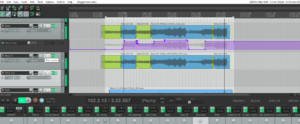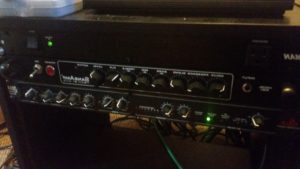Goat (Sea Piglet, 2017)
Goat (Sea Piglet, 2017)
This song is about the most fun I’ve ever had. This is another track by my good friend Beki, under the name of Sea Piglet. In addition to recording and mixing, I played cajon, bass, and other percussion, as well as contributing some … distinctive sounds toward the end. The goals with recording this were firstly to capture the energy of the song when we all play it together; secondly to get a feeling of ’90s rock on the grunge/punk/garage-band spectrum of things (the song was inspired partly by a Pixies song); and thirdly to have a great time throughout the process and hope that could come through in the recording.
The somewhat ridiculous, janky, and potentially misguided way we recorded:
In the same small room (the former bedroom where I have my studio set up) we had my brother Iain playing acoustic guitar, Beki singing vocals, and me playing cajon, all simultaneously; the guitar was into a cheap small-diaphragm condenser (Behringer C-2) while the vocals and cajon were both just into all-purpose Shure SM57s. These mics went into my old Mackie mixer (although the vocal mic went first into my dbx 286A) and were panned hard left (guitar mic), center (vocal mic), and hard right (cajon mic.) From there the mixer outputs went into the line inputs of my Focusrite 2i4 interface.
This is my workaround for using three or more microphones with only two inputs (just as I did on Lavender Earl Gray.) However, once in the computer, I started having a lot of trouble using Audacity to separate the three elements (left, center, and right). It seemed that the mid-side plugins I was using (such as Variety of Sound’s Rescue), or their interaction with Audacity, or… possibly… just the nature of mid-side processing in the first place… meant that I couldn’t truly separate the three components. However – once I bailed on Audacity and finally made the call to start using Reaper, I pretty much found that I could at least sort it out into vocals and a couple tracks of instruments, though of course there was not perfect isolation (as there wasn’t meant to be).

A Reaper project!
The end result: vocals with guitar and cajon in them, cajon with guitar and vocals in it, and guitar with cajon and vocals in it. In fact, the better part of the cajon sound (other than the very initial attack) came from the guitar mic. This means that I couldn’t manipulate each element totally independently, but everything I did (for example) to the vocal sound would also affect, to some degree, the overall guitar sound.
One way I got around this was by taking the vocal and sending a copy of that track to a separate bus where I rolled off a lot of low and low-mid frequencies on the bottom, and for good measure the super-high frequencies on the top, so I had just a narrow band that was primarily vocal sound without most of the body of the guitar. That copy of the vocal is what I applied distortion to, and what I sent to the delay effects (echoes.) This is, to put it mildly, much, much easier to do in Reaper than it would have been in Audacity. It is possible in Audacity, mind you, but holy cow is it less convenient. In this project, I auditioned several distortion effects and changed my mind repeatedly about which one to use, after having the delay set up. In Audacity, I would have had to back up, redo several steps, try the new distortion, and then send that to the delays. In Reaper, I could go back and change something like the distortion (or the high-pass filter before the distortion) without having to redo everything further down the chain.
Note: this is also what I always liked about working in Audacity. Because I couldn’t go back and change things after the fact, I had to try my best to get them right the first time, and commit to those choices. A lot of people out there will talk about the desirability of committing to ideas and not endlessly tweaking, but in practice it seems everyone likes the flexibility of infinite fidgeting.

The SansAmp RBI is great for getting bass amp tones without an amp. Could probably use digital amp emulators, but having real knobs to turn makes me feel special.
After that initial session where we got guitar, cajon, and vocals, we had a separate session of goat noises with myself, Iain, and our friend Cara, and separately I recorded bass (two layers, one clean and one distorted, through the SansAmp RBI by Tech 21) as well as tambourine and ride cymbal. I did those percussion elements with one of my newer mics, the sE 2200A II, which is fun for experimentation because it has multiple polar patterns – it can capture sound in all directions equally (omni), from the front and back (figure-8), or just in front (cardioid). I ended up using it in figure-8 for the tambourine and in cardioid for the ride cymbal, although I tried it in omni as well, and it seemed like that would sound great for a softer or jazzier context. It was amusing to me (possibly just because I’m easily amused) that these minor percussion parts were getting recorded with a nicer, more expensive mic than any of the main parts of the song, since the lead vocals were recorded through a standard old SM57.
I’ll stop rambling on now. Go forth and goat.